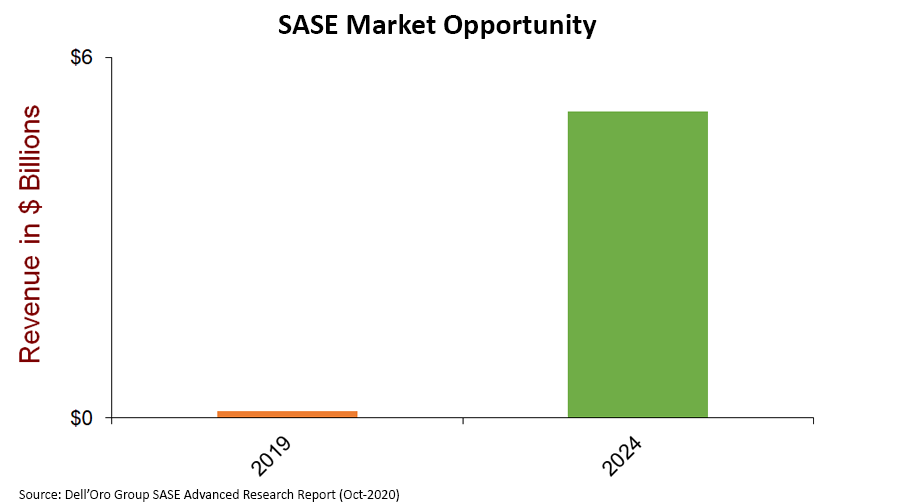
on Posted on Reading Time: 3 minutes
Recently, I was invited to participate in MEF’s Infinity Edge Series, Episode 3: SASE—Getting an Edge on SD-WAN, which focused on Secure Access Service Edge (SASE). I saw it as an excellent opportunity to help bring additional clarity to a topic that is all too often leaving people scratching their heads rather than turning on the proverbial light bulbs in their heads.
The challenges knocking at the enterprise’s door are too significant, and the opportunities to improve the state of networking and security are too enticing to ignore. In this blog, I want to hit on three themes from the session I shared with Ron Westfall, a fellow analyst from Futurum.
The Why: SaaS Applications and Remote Work as Key Drivers
In my view, the COVID-19 pandemic put two IT trends into hyperdrive:
- Shift from an on-premise to an Internet-based application infrastructure: It’s been over a decade since enterprises began shifting from on-premise to public cloud-based applications. However, the pandemic accelerated the adoption, as evidenced by the growth in the worldwide public cloud service provider revenue, which surpassed $100B for the first time in 2020, according to Dell’Oro analysis.
- Growth of a highly distributed remote workforce: According to Dell’Oro’s analysis of public research data, the pandemic in 2020 drove up to a 450% increase in the number of U.S. employees working remotely. We anticipate long-term remote work to remain elevated, particularly in market verticals based on knowledge work, where the rate is predicted to stay above 70%.
While neither of these trends is new, it’s the degree to which they now take place that forces the rethinking of enterprise networking and security strategy. Traditional approaches that assume clear network perimeters exist or rely on legacy multi-protocol line switching (MPLS) and virtual private network (VPN) technologies will no longer succeed. In the new normal, networking and security are intertwined and must be collectively addressed, and it is this intersection that gives rise to SASE.
The What: SD-WAN and Cloud-based SWGs Meet
Software-defined wide area networks (SD-WAN) and cloud-based secure web gateways (SWG) are solutions that arose independently in the late 2000s to address shortcomings of the legacy hub-and-spoke architectures that relied on MPLS and VPN technologies. SD-WAN emerged as an alternative to traditional MPLS-based networking, while cloud-based SWGs surfaced as a substitute to VPN-based remote access.
Both SD-WAN and cloud-based SWGs join the concepts of software-defined networking (SDN) and network function virtualization (NFV) to form solutions that are more scalable, flexible, and provide a better total cost of ownership than legacy approaches. Considering the architectural commonalities between SD-WAN and cloud-based SWGs, it was inevitable that these two technologies could meet into an integrated platform called SASE.
The integration of SD-WAN and cloud-based SWGs will be a multi-year journey. SASE solutions are in the early adoption phase, several years away from becoming mainstream for several reasons, such as the diversity and maturity in vendor implementations or enterprises’ ability to align internal IT teams and budgets. But we believe SASE holds great appeal. We predict this market will grow significantly from 2019 to 2024 at a compounded annual growth rate (CAGR) of 116%, attaining north of $5 B in 2024 and with strong positive upside potential.

The How: Standardizing SASE to Make the Journey Easier
We can all agree that a great contributor to Ethernet’s success and popularity has been vendor interoperability. We almost take it for granted that Ethernet from various vendors will just work. But in fact, multi-vendor interoperability is tough and stems from the difficult work that starts with the standards process. I know it’s hard work from my experiences in participating and owning networking or security standards development in groups like IETF (Internet Engineering Task Force) or Trusted Computing Group (TCG). At times, the rate of progress felt on par with the U.S. Senate or Congress, which admittedly has been glacial of late.
While SASE is in its early days, I applaud the SASE standardization efforts that MEF has undertaken. In the near term, they are contributing vocabulary and aligning conceptual frameworks that are vital to getting the industry to rally behind common implementation approaches. In the long term, let us hope that the resulting standards help make multi-vendor SASE a reality and accelerate adoption.
Ultimately, SASE isn’t a revolution, but is another part of the long-standing evolutionary arc of IT—really, the multi-decade journey we’ve been on—that will touch many aspects of the enterprise IT landscape in terms of people, process, and technologies, and holds great promise in increasing scalability, agility, and security of the network.
Learn More
- MEF’s work on SASE Service Standards
- Watch MEF’s Infinite Edge Episode 3: SASE—Getting an Edge on SD-WAN
About MEF’s Infinite Edge Series
Our free digital series brings together ICT industry luminaries, executives and subject-matter experts to share their vision, experience and expertise on networking, automation, and digital services—over the course of 9 episodes in an immersive, fully interactive digital environment.
Get the edge on your digital transformation journey with insights and expertise. Get more details and register for all 9 episodes: MEF Infinite Edge Series
About Dell’Oro Group
Founded in 1995 with headquarters in the heart of Silicon Valley, Dell’Oro Group is an independent market research firm that specializes in strategic competitive analysis in the telecommunications, networks and data center IT markets. Our firm provides world-class market information with in-depth quantitative data and qualitative analysis to facilitate critical, fact-based business decisions. Visit us at www.delloro.com

